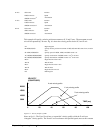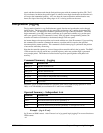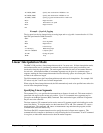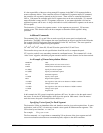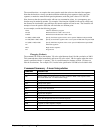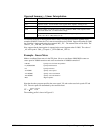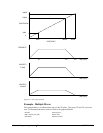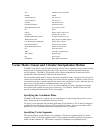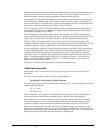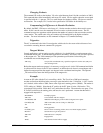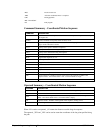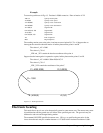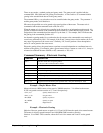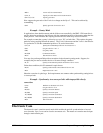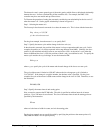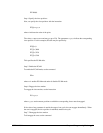
Chapter 6 Programming Motion • 74 USER MANUAL
Immediately prior to the execution of the first coordinated movement, the controller defines the current
position to be zero for all movements in a sequence. Note: This ‘local’ definition of zero does not
affect the absolute coordinate system or subsequent coordinated motion sequences.
The command, VP xy specifies the coordinates of the end points of the vector movement with respect
to the starting point. The command, CR r,q,d define a circular arc with a radius r, starting angle of q,
and a traversed angle d. The notation for q is that zero corresponds to the positive horizontal direction,
and for both q and d, the counter-clockwise (CCW) rotation is positive.
Up to 511 segments of CR or VP may be specified in a single sequence and must be ended with the
command VE. The motion can be initiated with a Begin Sequence (BGS) command. Once motion
starts, additional segments may be added.
The Clear Sequence (CS) command can be used to remove previous VP and CR commands which
were stored in the buffer prior to the start of the motion. To stop the motion, use the instructions STS
or AB1. ST stops motion at the specified deceleration. AB1 aborts the motion instantaneously.
The Vector End (VE) command must be used to specify the end of the coordinated motion. This
command requires the controller to decelerate to a stop following the last motion requirement. If a VE
command is not given, an Abort (AB1) must be used to abort the coordinated motion sequence.
It is the responsibility of the user to keep enough motion segments in the DMC-13X8 sequence buffer
to ensure continuous motion. If the controller receives no additional motion segments and no VE
command, the controller will stop motion instantly at the last vector. There will be no controlled
deceleration. LM? or _LM returns the available spaces for motion segments that can be sent to the
buffer. 511 returned means the buffer is empty and 511 segments can be sent. A zero means the
buffer is full and no additional segments can be sent. As long as the buffer is not full, additional
segments can be sent at PC bus speeds.
The operand _CS can be used to determine the value of the segment counter.
Additional commands
The commands VS n, VA n and VD n are used for specifying the vector speed, acceleration, and
deceleration.
VT is the s curve smoothing constant used with coordinated motion.
Specifying Vector Speed for Each Segment:
The vector speed may be specified by the immediate command VS. It can also be attached to a motion
segment with the instructions
VP x,y < n >m
CR r,
θ,δ < n >m
The first command, <n, is equivalent to commanding VSn at the start of the given segment and will
cause an acceleration toward the new commanded speeds, subjects to the other constraints.
The second function, > m, requires the vector speed to reach the value m at the end of the segment.
Note that the function > m may start the deceleration within the given segment or during previous
segments, as needed to meet the final speed requirement, under the given values of VA and VD.
Note, however, that the controller works with one > m command at a time. As a consequence, one
function may be masked by another. For example, if the function >100000 is followed by >5000, and
the distance for deceleration is not sufficient, the second condition will not be met. The controller will
attempt to lower the speed to 5000, but will reach that at a different point.



